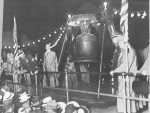Letter to the Editor
The Liberty Bell did get around
Monday, August 23, 2010

The Liberty Bell, above, in McCook during its 1915 tour to the West Coast
The Liberty Bell is one of the best known symbols of the United States and the freedom that we all too often take for granted in this country. Yet, in the beginning it was not a symbol for the United States. It predated the Declaration of Independence and the United States Constitution, and was originally brought to the United States in 1752 by the people of Pennsylvania to commemorate the 50th Anniversary of William Penn's issuing his Charter of Privileges, which stated that the colonists in the new world had the right to govern themselves, certainly a major step by the colonists on their road to Independence and the overthrow of British rule.
The Bell was originally cast in London by the White Chapel Bell Foundry and hung in the Pennsylvania State House. It carried the inscription, "Proclaim Liberty thro' all the Land to all inhabitants thereof." Lev. XXV.VX. The Liberty Bell has had an interesting history. Its earliest years were stormy ones. It cracked the first time it was rung. Then, in 1753 it was melted down and recast (twice) by the American firm of Pass & Stow. More copper was added to make it less brittle, silver added to sweeten the tone. Unfortunately, this did not prevent new cracks from appearing.
For the first 75 years the Bell was simply known as the (Pennsylvania) Statehouse Bell. It was rung in 1776 at the first reading of the Declaration of Independence, and it was rung for other important occasions, such as elections, and the death of a President. It cracked again in 1835 while it was being rung to mark the death of Chief Justice of the Supreme Court, John Marshall, one of the original signers of the Declaration of Independence. After that it was decided to just leave the 24" crack, which has become a key feature of The Liberty Bell.
In 1777 British troops threatened to invade Philadelphia. To prevent the British from seizing the bell and melting it into bullets to be used against the Patriots, the bell was removed to Allentown PA, where it was hidden beneath the floorboards of the Zion Reformed Church.
Around 1839 the Abolitionists began using the Bell as their symbol, and referred to it in their anti-slavery publications. They gave it the name of "Liberty Bell" when they used it as the centerpiece of their publication, Liberty, in 1837.
Hairline cracks continued to show up in the bell over the years. Various means were attempted to make repairs, and the bell continued to be rung. However, in 1846, when the Liberty Bell was rung as part of an occasion to celebrate George Washington's birthday, a new large crack, which we see today, appeared and it was determined that the Liberty Bell would ring no more.
The Liberty Bell was an important symbol for the American people, even after it ceased to ring. In the years after the Civil War, it embarked on a series of "barnstorming patriotic journeys", always via railroad, through the north and the south, to help heal the wounds caused by the war. The appearances were successful, and more journeys were planned after that, to Worlds Fairs and Expositions, where large crowds invariably turned out to see this famous and inspiring bell.
1885 -- Philadelphia to New Orleans for the World's Industrial and Cotton Centennial Exposition.
1893 -- Philadelphia to Chicago for the World's Columbian Exposition.
1895 -- Philadelphia to Atlanta for the Cotton States International Exposition.
1902 -- Philadelphia to Charleston South Carolina,, for the Interstate and West Indian Expo.
1903 -- Philadelphia to Boston for the 128th Anniversary. of the Battle of Bunker Hill.
1904 -- Philadelphia to the St. Louis World's Fair, to commemorate the Louisiana Purchase.
1915 -- Philadelphia to San Francisco for the Panama-Pacific Exposition and on to San Diego for the Panama-California Exposition. Note: This journey followed the Burlington route and McCook was one of the places where it stopped. Arlene Strunk, the wife of the Gazette's founder, Harry Strunk, remembered that school children were excused from school and marched to the depot to see the Liberty Bell.
The 1915 trip was the last for the Liberty Bell, but not the last for its likenesses. In 1926 a huge, 80 foot replica of the Liberty Bell served as the main gate to the Philadelphia Sesqui-Centennial International Expo. People, cars, and trucks passed beneath a giant bell to enter the fairgrounds. At night it was lighted with 26,000 light bulbs.
After World War I, the Liberty Bell was at home on the first floor of Independence Hall in Philadelphia, where it stood for more than 50 years. However, in 1975 it was moved to temporary quarters across the street because it was feared that the crush of Bi-Centennial visitors would cause damage to the Hall and to the Bell.
In 2003 to Liberty Bell was moved into its new, much larger home, complete with an impressive interpretive exhibit, describing the Bell's significance to the American people. Each year more than 2 million visitors view the Liberty Bell against the backdrop of its old home, Independence Hall.
The Liberty Bell's likeness was used on a commemorative coin, minted to mark the 125th Anniversary of American Independence in 1926, the same year that it was used on a United States 2 cent stamp. From 1948 to 1963 it was used on the reverse side of the Franklin half-dollar, and also on the Eisenhower dollar. Since 2007 The Liberty Bell is seen on the U.S. "Forever" stamps, which grow in value with each postal increase.
Though the Liberty Bell is now silent and stationary, it seems that it will continue to spread its inspirational message of American Freedom far into the future.
Source: Buzzle.com, UShistory.org, McCook Gazette, Centennial edition

